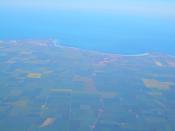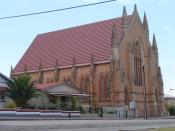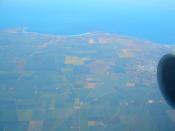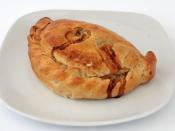Instead of a bath tub or shower washbasin's or a cast iron pot were used. The water had to be pumped from the water pump in the front garden. Many of the Cornish houses were built without a plan for a bathroom. Water was drawn from an underground tank and heated on the kitchen fire. The toilet/lavatory used were earth closets consisting of a plain wooden toilet seat and a long drop. Ashes from the house would have been poured tipped into the pit and squares of newspaper used instead of toilet paper. As the family grew it was common to extend the house. This can be seen because of the uneven roof extensions as the additional rooms were added on to the cottages which started off with only two rooms.
Life during the copper rush was hard on the many families that lived there. Many of the men worked in the copper mines and did not see the light of day.
A typical day started at 6:00 am and finished at 6:00pm when they would return home to their wives who looked after the home. Lunch would be a Cornish pasty which was cooked by the "missus". Young boys of ten and over would often join their fathers at the site and pick through the tailings for copper pieces of any value. These boys were often called young "picky boys". The young girls would stay at home with their mother and help with the domestics and looking after the kids. There were many cases when a mining accident occurred and father was killed. This would be a major economic loss and often when this happened, the women were lent pressing machines to help them earn money. If there was a young son he would be able to earn a little money working as a "picky boy" in the tailing heap. If their family was part of a guild they would receive a small amount of money to live off. If the mother died, often the younger family members would also die as father would be to busy working to look after his children. When we visited the cemetery at Moonta it was seen that the life expectancy of those living in the 1860's would be shorter. Many young children were buried with their mothers, often only a couple of weeks old. This would probably have been because of the difficulty of childbirth. All child birth's were natural and if anything went wrong often the mother and baby would die together. The most common reason of death would be from working in the mines, diseases due to poor hygiene and the death of a mother or father figure. The oldest age of death was 83 and the youngest a mere 2 weeks.
The Wheal Hughes engine house (see appendix Five) is still standing to this day and is a constant reminder of the hard work that many of the Cornish miners had to endure to bring home the bread to feed their families. Wheal is the Cornish word for mine, and Hughes is named after Walter Watson Hughes, a mine owner in Moonta and a major benefactor of South Australia. Hughes Engine House was erected in 1865, It closed in 1923. It was the second mine to be dug during the 1980's. It was initially worked as an open cut mine before the underground working was dug. During it's period of operation 13 workers were employed. It's job was to pump water from the adjacent shaft to a depth of 366 m and from Taylors shaft about 300 meters to the north to a depth of 768 metres. (see appendix Five) The Cornish were very superstitious. They believed in small figures called the "Cornish piskey". They believed that the little people, "sprinnigans" would play tricks on them, cast spells and steal babies. The Cornish fold would respect their presence and be careful not to do anything to annoy or disturb them. Cornish were religious and often hung many religious relics in every room. The "Kernewek Lowender" is held every two years to celebrate the Cornish cultures that the Cornish have brought over with them from Cornwall. The celebrations can run for over a week in time and is acknowledged as the world's biggest festival of Cornish culture. Some of the traditional foods which we enjoy are the Cornish pasties, and their traditional beer, "swanky". They also have the traditional furry dances and the Scottish game of high jinks. (see appendix Six) In 1923 when the copper was exhausted, the towns of Moonta, Kadina and Wallaroo needed to find new ways to make money. They now earn a lot of money from farming wheat and barley, fishing in the near by bays, breeding sheep and cattle, exporting goods from the Wallaroo ports and the production of fertilisers. Tourism is also a large economic booster with many people from all around the world come to look at the small towns of Moonta, Kadina and Wallaroo who have earnt themselves the name of the "copper triangle" due to the large amounts of copper which were extracted during the 1860's. You can go to Moonta to visit old mining communities and go underground at the Wheal Hughes mine or follow a trail on the Moonta heritage walk . The surrounding beaches are safe for water sports, boating and diving. (see appendix Seven) Moonta, Kadina and Wallaroo promise the ultimate escape from the city stress, some of the most appealing features would be the relaxed, uncrowded tranquil atmosphere, gentle Mediterranean climate and the friendliness of the locals. But above all it is the past that makes these three towns unique and have earnt them the name of the famed "copper triangle".



